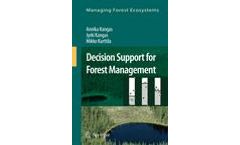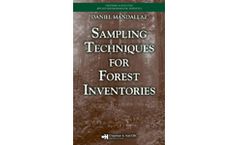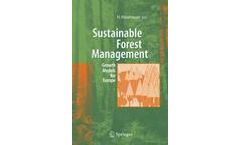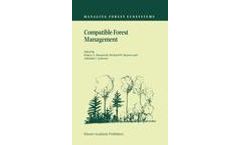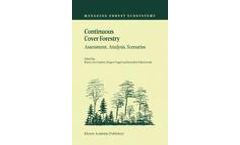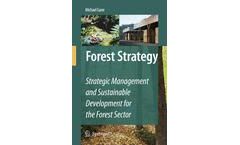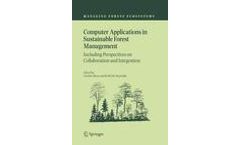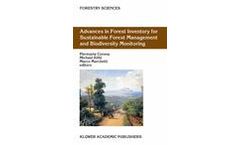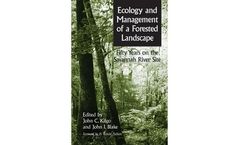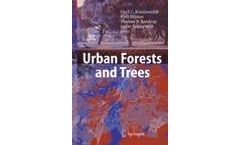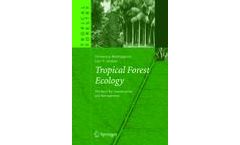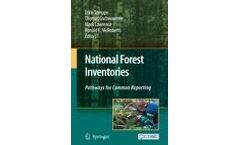Refine by
forest-management books
46 books found
The goal of Kangas, Kangas and Kurttila's Decision Support for Forest Management is to provide students and researchers with a toolbox of methods for approaching the different planning situations that may arise in practice. It draws together a wide range of methods used in planning forest management regimes and presents a ...
Due to the long-term planning horizons and the great variety of natural, economic, and operational hazards affecting forest ecosystems, uncertainty and multiple risk are typical aspects of forest management. Applications of risk analysis are surprisingly rare, in spite of the rich assortment of sophisticated forest planning ...
Sound forest management planning requires cost-efficient approaches to optimally utilize given resources. Emphasizing the mathematical and statistical features of forest sampling to assess classical dendrometrical quantities, Sampling Techniques for Forest Inventories presents the statistical concepts and tools needed to conduct ...
There is a strong movement towards uneven-aged forest management based on the idea that such stands increase or at least maintain soil fertility, increase biodiversity, and improve stand resilience. This shift in forest management practice renders existing yield tables increasingly unreliable. Among potential alternatives are ...
Public debate has stimulated interest in finding greater compatibility among forest management regimes. The debate has often portrayed management choices as tradeoffs between biophysical and socioeconomic components of ecosystems. Here we focus on specific management strategies and emphasize broad goals such as biodiversity, wood ...
This involves a gradual tarnsformation of traditional silvicultural practice towards Continuous Cover Forestry (CCF), also know as near-natural forest management, favouring mixed uneven-aged stands, site-adapted tree species and selective harvesting. ...
Bioenergy from Sustainable Forestry synthesizes information needed to design or implement sustainable forest management systems for production of biomass for energy in conjunction with other forest products. It is organized around the criteria for sustainable forest management: productivity, environment, social ...
Michael Gane’s ground-breaking Forest Strategy combines detailed analysis of the forest sector with modern strategic management principles to develop a vision for sustainable forest management which is both practical and theoretically robust. In the past, lack of understanding at the nexus between the ...
Forests provide goods and services essential to human societies and the natural environment, but they are disappearing faster today than ever before. ...
The increasing awareness and concern of people, researchers and decision makers for the maintenance and enhancement of goods and services provided by forest ecosystems significantly widened the scope of information needs for sustainable forest management on the task-specific, integrative and strategic level. Forest resource ...
With its 250-year history, Sustainable Forest Management (SFM) is now viewed as a model for managing forests worldwide. ...
The contributions are by senior scientists and represent all the major forested regions of the world. The book constitutes a comprehensive treatment of the state of our knowledge on patterns of resistance by insect guilds and how this knowledge can be deployed to achieve the management of damaging ...
Forest Fires are very complex phenomena which, under the right physical conditions, can rapidly devastate large areas, as demonstrated by recent events. There is also widespread awareness that the risk may increase as a result of climate changes. Different approaches are required for controlling fires in rural areas as opposed to urban environments, which strongly depend on the physical ...
This book tells the story of fifty years of restoration and management of the forested landscape of the Savannah River Site, a 310-square-mile tract of land in the coastal plain of South Carolina that has been closed to the public for more than five ...
Almost half of all life on earth may exist in the world's forest canopies. They may also play a vital role in maintaining the planet's climate, yet they remain largely unexplored owing to difficulties of access. They are renowned for their great diversity and role in forest functioning, yet there are still great gaps in the understanding of this 'last biological frontier'. This seminal book ...
During the 4th International Consultation on Forest Genetics and Tree Building, held in 1998 in Beijing, China, leading scientists were invited to review past achievements, to redefine the role of forest genetics and breeding in contemporary forestry, and to set priorities for future research and development. On the basis of the invited presentations, the volume summarizes the state of ...
The economics of sustainability is much more complex than the neoclassical (Newtonian) economic approach to economic efficiency. Forest resources provide the ideal starting point for the economic analysis of sustainability. This book provides a systematic critique of neoclassical economic approaches and their limitations with respect to sustainability. Leading economists from different streams of ...
This book covers all aspects of planning, designing, establishing and managing forests and trees and forests in and near urban areas. The disciplinary background of the authors is varied, ranging from forestry and horticulture to landscape ecology, landscape architecture and even plant pathology. ...
Research in tropical forestry is confronted with the task of finding strategies to alleviate pressure on remaining forests, and techniques to enhance forest regeneration and restore abandoned lands, using productive alternatives that can be attractive to local human populations. In addition, sustainable forestry in tropical countries must be supported by adequate policies to promote and maintain ...
Traditionally the purpose of National Forest Inventories (NFIs) has been to provide continuously updated information regarding the state of a given nation’s forest resources, including their timber volumes, species composition and sustainable development. But with increased international reporting requirements – to the FAO, the ITTO, the UN’s Framework Convention on Climate Change, the ...

